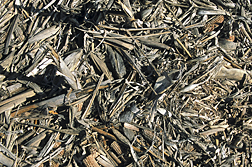This page has been archived and is being provided for reference purposes only. The page is no longer being updated, and therefore, links on the page may be invalid.
| Read the magazine story to find out more. |
|
|
|
|
Corn Cobs Eyed for Bioenergy Production
By Ann PerryJanuary 31, 2013
Corn crop residues are often left on harvested fields to protect soil quality, but they could become an important raw material in cellulosic ethanol production. U.S. Department of Agriculture (USDA) research indicates that soil quality would not decline if post-harvest corn cob residues were removed from fields.
This work, led by Agricultural Research Service (ARS) soil scientist Brian Wienhold, supports the USDA priority of developing new sources of bioenergy. ARS is USDA's chief intramural scientific research agency.
Wienhold, with the ARS Agroecosystem Management Research Unit in Lincoln, Neb., led studies that compared runoff rates and sediment loss from no-till corn fields where postharvest crop residues were either removed or retained. The scientists also removed cobs from half of the test plots that were protected by the residues.
After the test plots were established, the scientists generated two simulated rainfall events. The first occurred when the fields were dry, and the next occurred 24 hours later when the soils were almost completely saturated.
During the first event, on plots where residue was removed, runoff began around 200 seconds after the "rain" began. Runoff from plots protected by residues didn't start until around 240 seconds after it started to "rain."
Runoff from the residue-free plots contained 30 percent more sediment than runoff from all the residue-protected plots. But the presence or absence of cobs on the residue-protected plots did not significantly affect sediment loss rates.
Wienhold's team concluded that even though cob residues did slightly delay the onset of runoff, sediment loss rates were not significantly affected by the presence or absence of the cobs. The results indicated that the cobs could be removed from other residue and used for bioenergy feedstock without significantly interfering with the role of crop residues in protecting soils.
In a related study, Wienhold examined how the removal of cob residues affected soil nutrient levels. Over the course of a year, his sampling indicated that cobs were a source of soil potassium, but that they weren't a significant source of any other plant nutrients.
Results from this work have been published in Agronomy Journal.
Read more about the research in the January 2013 issue of Agricultural Research magazine.

